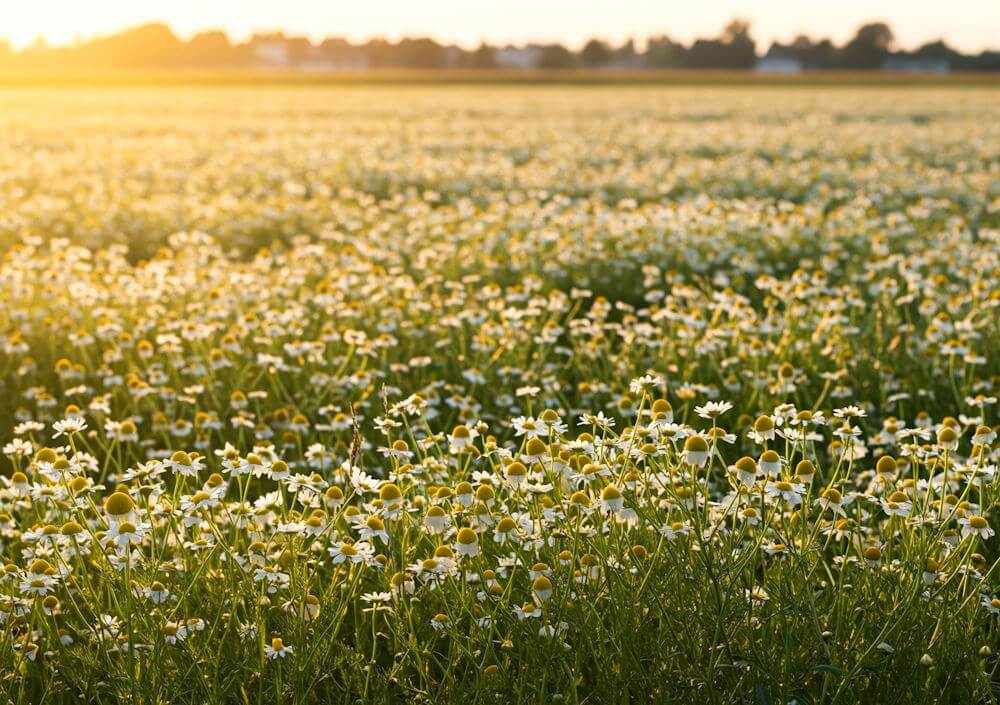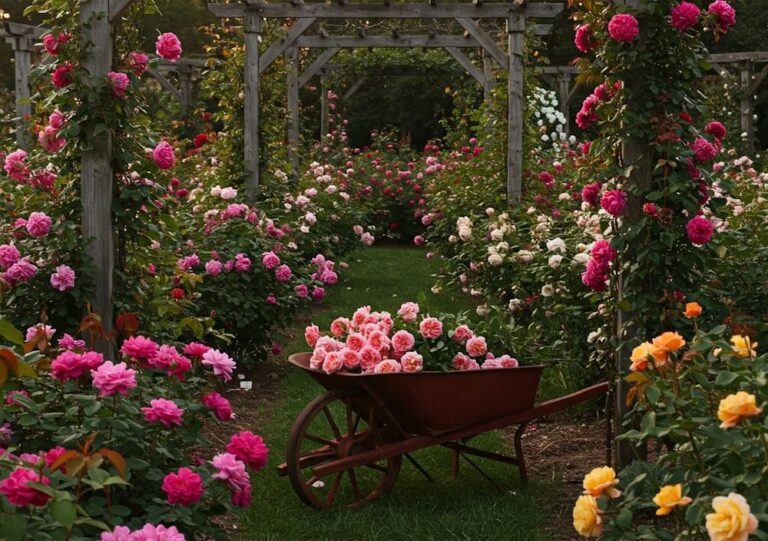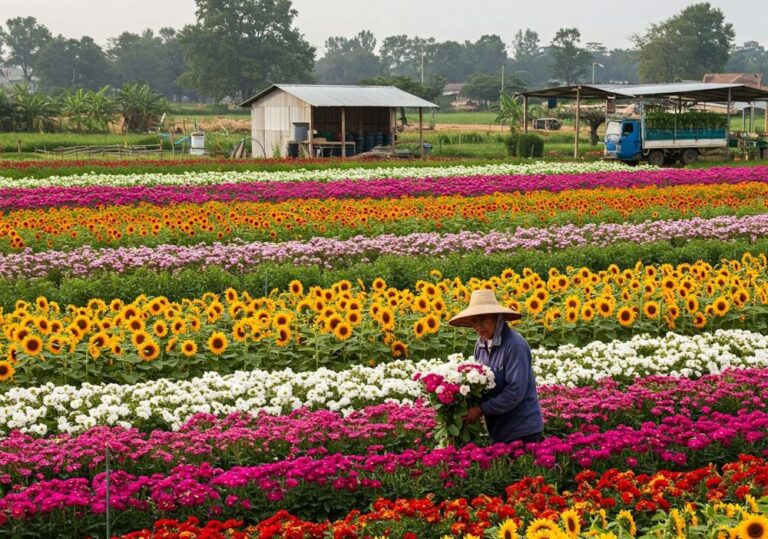Chamomile, a member of the Asteraceae family, has been cultivated for centuries for its therapeutic and aromatic properties. Originating from Europe and Asia, this flowering herb is recognized for its daisy-like blossoms and distinctively soothing scent. Historically, chamomile has been utilized in various cultural traditions, often associated with relaxation and gastrointestinal relief. Its significance is further underscored by records dating back to ancient Egypt, where it was revered for its healing qualities and even employed in the embalming process.
In contemporary settings, chamomile farming has gained prominence due to the increasing demand for organic and natural products. The herbal industry has experienced a remarkable surge in interest, leading to a measurable rise in the cultivation of chamomile across different regions. Farmers and entrepreneurs are increasingly inclined toward chamomile farming, recognizing the crop’s versatility and multiple applications. The dried flowers of chamomile are primarily used to produce herbal teas, which have become a staple in health-conscious markets. Additionally, essential oils extracted from chamomile are favored in the cosmetic industry, valued for their soothing and anti-inflammatory properties.
Chamomile is not only cherished for its practical uses but also for its easy cultivation requirements. It thrives in various soil conditions and climates, making it an accessible crop for both seasoned and novice farmers. As consumers increasingly gravitate toward natural remedies and sustainable practices, chamomile is being acknowledged as a lucrative option in the sphere of agriculture. This signals a promising future for chamomile farming, particularly as awareness about its numerous benefits continues to spread. Its growing significance in traditional and modern agriculture reflects a broader trend toward embracing herbal products, solidifying chamomile’s status as a crop of substantial value in the current market landscape.
Types of Chamomile
Chamomile, a well-regarded herb known for its calming properties, primarily comprises two main types: German chamomile (Matricaria chamomilla) and Roman chamomile (Chamaemelum nobile). Understanding their distinct characteristics, growth conditions, and uses can greatly benefit farmers in making informed decisions about which type to cultivate.
German chamomile is an annual plant that typically grows up to 24 inches tall. It features white flowers with yellow centers and is known for its high essential oil content, particularly chamazulene and alpha-bisabolol. These compounds contribute to its renowned anti-inflammatory and sedative effects. German chamomile thrives in slightly acidic to neutral soils and requires full sun to achieve optimal growth. Given its rapid life cycle, with flowering occurring around 60-70 days post-seeding, farmers may opt for this variety to obtain quicker yields and respond swiftly to market demands.
In contrast, Roman chamomile is a perennial herb that can reach heights of about 12 inches. It boasts a more robust flavor profile, often characterized as sweet and apple-like. Roman chamomile is drought-resistant, making it suitable for less humid climates and well-drained soils. This variety’s longevity allows for multiple harvests over the years, which can be advantageous for farmers looking to build sustainable practices and minimize the need for replanting. Its essential oils, while differing in composition from German chamomile, also possess therapeutic qualities and can be used in various products ranging from herbal teas to cosmetics.
When choosing between these two types of chamomile, farmers should consider their local climate, soil conditions, and market preferences. Both varieties offer unique benefits and profitable opportunities, making chamomile farming a worthy and calming venture for those entering this flourishing herb sector.
Growing Conditions for Chamomile
Chamomile, renowned for its calming properties and versatile uses, thrives under specific growing conditions that farmers should understand to ensure optimal yields. First and foremost, the soil type plays a pivotal role in chamomile cultivation. Well-draining sandy or loamy soil, rich in organic matter, is ideal for this herbaceous plant. The soil should have a pH level ranging from 6.0 to 7.0, as this balance promotes nutrient absorption essential for the plant’s growth. Farmers are advised to conduct a soil test before planting to determine any necessary amendments, thereby enhancing soil fertility and structure.
In terms of climate, chamomile is best suited to temperate regions where temperatures range between 60°F and 68°F (15°C to 20°C). This crop can tolerate cooler conditions; however, excessive heat may hinder its growth and flowering. Therefore, it is crucial to select a growing site that provides the right climate to facilitate healthy development. Additionally, chamomile requires a minimum of six hours of sunlight daily, making a well-placed field vital for the crop’s success.
Watering requirements are another essential factor in chamomile farming. While this plant prefers moderately moist conditions, it is sensitive to waterlogged soil, which can lead to root rot. Farmers should aim to provide about one inch of water per week, either through rainfall or irrigation, particularly during the flowering stage. To ensure that the chamomile plant remains healthy, utilizing mulch can help retain soil moisture while reducing weed competition.
By understanding these key growing conditions, farmers can create an optimal environment for chamomile cultivation, ultimately meeting the rising demand for this sought-after crop. Proper preparation and management of soil, climate, and water will set the foundation for a fruitful chamomile harvest.
Planting and Cultivation Techniques
Successful chamomile farming begins with the careful selection of seeds. There are two primary types of chamomile used in agriculture: German chamomile (Matricaria chamomilla) and Roman chamomile (Chamaemelum nobile). German chamomile is notably popular due to its higher essential oil yield, making it an ideal choice for commercial purposes. Selecting high-quality seeds from reputable suppliers ensures optimal germination rates and healthy plants.
Sowing techniques play a crucial role in chamomile cultivation. This delicate crop prefers well-drained soil, rich in organic matter. Before planting, the soil should be prepared by tilling to a depth of about 12 inches, mixing in compost to enhance fertility. Chamomile seeds can be sown directly into the soil in early spring or fall. A common method is to broadcast the seeds evenly over the desired area and lightly rake them into the soil. It is important to maintain a spacing of approximately 12 inches between plants to allow for adequate growth and airflow.
Care and maintenance practices are essential for enhancing the growth and yield of chamomile crops. Regular watering is necessary, especially during dry spells, but care should be taken not to overwater, as chamomile prefers slightly dry conditions. Additionally, implementing organic farming methods, such as using natural fertilizers, can promote plant health while minimizing environmental impact. Pruning is also beneficial; removing spent flowers encourages the production of new blooms and prolongs the flowering period.
Pest control is another critical aspect of chamomile farming. Integrated pest management (IPM) strategies, such as introducing beneficial insects and utilizing organic pesticides, can help keep pests at bay while ensuring the crop remains healthy. By following these techniques, farmers can cultivate high-yield chamomile plants that meet the increasing demand for this calming herb.
Harvesting Chamomile
Chamomile harvesting is a critical phase in the cultivation process, influencing both the quality and economic value of the flowers. Typically, the optimal time for harvesting chamomile is during full bloom when the flowers display fully opened white petals surrounding a bright yellow disc. This phase usually occurs from late spring to early summer, depending on the specific variety and local climate conditions. It is essential to observe the plants closely, as timing can vary; missing the peak bloom can result in a decline in the essential oil concentration and overall quality.
To ensure the best quality during harvesting, the recommended technique involves cutting the flowers at the base, ideally using sharp shears or knives. This method minimizes damage to the plant and facilitates a cleaner cut, which can promote regrowth after harvesting. It is advisable to harvest chamomile in the morning after dew has evaporated, as this helps retain the essential oils and prevents the flowers from becoming overly moist. Additionally, avoiding harvesting during wet weather conditions is crucial to reduce the risk of mold and preserve the aromatic properties of the chamomile.
Once harvested, immediate handling of chamomile is pivotal to maintain its quality. The flowers should be gently placed in containers that allow for airflow, preventing crushing and bruising. It is advisable not to pack them too tightly to ensure they remain undamaged. Following this, prompt drying is necessary; chamomile flowers should be dehydrated in a shaded, well-ventilated area, away from direct sunlight, which can degrade their vibrant color and therapeutic properties. Proper processing can elevate the marketability of the chamomile, ensuring it retains its valuable constituents for the herbal tea and essential oil markets, ultimately catering to the strong demand for this calming crop.
Market Demand and Economic Potential
The market demand for chamomile has shown significant growth in recent years, driven by an increasing consumer inclination toward natural health products and herbal remedies. Recent statistics indicate that the chamomile market is projected to grow at a compound annual growth rate (CAGR) of approximately 10% from 2021 to 2028, reaching an estimated valuation of several billion dollars. This impressive growth underscores the economic potential of chamomile farming as a viable agricultural venture.
One of the leading buyers of chamomile is the herbal tea industry, which has witnessed a surge in popularity among health-conscious consumers. The increasing awareness of the potential health benefits associated with chamomile, such as its calming properties and ability to assist with sleep disorders, has spurred demand. Additionally, chamomile extracts are gaining traction in the cosmetics and skincare industries, where they are sought for their soothing and anti-inflammatory effects.
Pricing for dried chamomile flowers can vary significantly based on quality and market dynamics. On average, farmers can expect to receive between $20 to $40 per kilogram for top-quality chamomile flowers, making it a lucrative crop when managed effectively. The economic feasibility of chamomile farming is further enhanced by its low input costs and relatively high yield potential, with farms reporting yields of up to 1,500 kilograms per hectare.
Farmers looking to harness this market potential can adopt various strategies. Establishing direct relationships with local tea companies, wholesalers, or even participating in farmers’ markets can ensure better pricing and create community awareness about chamomile’s benefits. Additionally, tapping into global markets via e-commerce platforms can provide even greater opportunities for profit. Thus, ensuring effective marketing and distribution strategies can significantly enhance the economic viability of chamomile cultivation.
Challenges in Chamomile Farming
Chamomile farming, while offering significant benefits, is not without its challenges. Farmers may encounter various obstacles that can affect both yield and quality. One primary concern is the susceptibility of chamomile plants to a range of diseases. Conditions such as root rot, caused by overwatering or poor drainage, can severely impact crop viability. Additionally, fungal infections like powdery mildew can thrive in humid environments, jeopardizing the integrity of the harvest. Implementing proper agronomic practices, including crop rotation and timely irrigation, plays a crucial role in disease management.
Pests also pose significant threats to chamomile crops. Insects such as aphids, spider mites, and caterpillars can damage plants, leading to reduced yields and compromised quality. Integrated pest management (IPM) strategies, which involve biological control methods and the use of resistant varieties, can help farmers mitigate the risk of infestations while minimizing the need for chemical interventions. Monitoring pest populations regularly allows farmers to take proactive measures, fostering a healthier crop overall.
Furthermore, competition within the agricultural sector can make chamomile farming challenging. As the demand for organic and natural products rises, many farmers are turning to chamomile cultivation, increasing market saturation. Differentiating one’s product through quality, branding, and effective marketing strategies is paramount. Establishing strong relationships with buyers and exploring niche markets can enhance competitiveness.
In addition, climatic factors such as temperature fluctuations and irregular rainfall can adversely affect chamomile growth. Adopting sustainable farming practices, such as soil conservation techniques and water management systems, can help farmers adapt to changing climatic conditions. Awareness and preparedness for these challenges are essential for successful chamomile farming, ensuring that growers can meet demand while overcoming the inherent risks in this industry.
Sustainability Practices in Chamomile Farming
Sustainable farming practices are vital to the cultivation of chamomile, a crop renowned for its calming properties and significant demand in the market. By adopting organic farming methods, chamomile growers can not only reduce their environmental footprint but also appeal to an increasingly eco-conscious consumer base. Organic agriculture emphasizes the use of natural fertilizers, crop rotation, and pest management techniques that protect the soil and surrounding ecosystems.
Soil health is an essential aspect of chamomile farming sustainability. Healthy soil promotes robust plant growth and enables crops to resist diseases and pest infestations. Practices such as cover cropping and the application of compost enrich the soil with organic matter, enhancing nutrient availability. Furthermore, minimizing soil disturbance through reduced tillage can preserve soil structure, resulting in better water retention and root development, which are crucial for chamomile cultivation.
Water conservation is another critical component of sustainable farming. Effective water management strategies, such as drip irrigation and rainwater harvesting, can significantly reduce water usage while ensuring that chamomile plants receive adequate moisture. This approach not only conserves precious water resources but also lowers the costs associated with irrigation, contributing to the overall efficiency of the farming operation.
By implementing these sustainable farming practices, chamomile cultivators can enhance their market appeal. Consumers are increasingly drawn to products that are grown in an environmentally-friendly manner. As such, chamomile farmers may find that adhering to sustainable practices can result in higher prices for their crops and increased market share. Engaging with sustainability not only meets the demands of consumers but also promotes a healthier planet for future generations.
Future Trends in Chamomile Farming
The future of chamomile farming appears to be promising, driven by several factors, including technological advancements, evolving consumer preferences, and openings in new markets. As more farmers begin to recognize the health benefits and market demand for chamomile, innovative practices and technologies are likely to emerge, revolutionizing how chamomile is cultivated, harvested, and marketed.
Modern agriculture has witnessed the integration of precision farming technologies, such as data analytics and the Internet of Things (IoT). These innovations allow farmers to monitor soil conditions, optimize irrigation, and apply fertilizers more efficiently. In chamomile farming, adopting such technologies can enhance crop yield and reduce production costs. Precision agriculture not only improves productivity but also ensures a sustainable approach to farming by minimizing waste and environmental impact.
Consumer preferences are also shifting, leading to an increased demand for organic and naturally sourced chamomile products. As health-conscious consumers opt for herbal remedies over traditional pharmaceuticals, the market for chamomile tea and essential oils is expanding. This trend presents chamomile farmers with the opportunity to tap into organic certifications and promote their products more effectively, catering to a growing demographic interested in wellness-focused offerings.
The exploration of new markets is another crucial trend within chamomile farming. As global demand for herbal products rises, farmers can look beyond traditional markets and consider exporting to countries where herbal tea consumption is increasing. Additionally, innovative product development, such as chamomile-infused cosmetics and dietary supplements, can open up new revenue streams. This diversification can protect farmers from market volatility and create sustainable business opportunities.
In conclusion, the future of chamomile farming is shaped by technological innovations, changing consumer habits, and the potential for market expansion. Farmers who adapt to these trends can significantly enhance their operations and achieve substantial growth in this lucrative sector.





